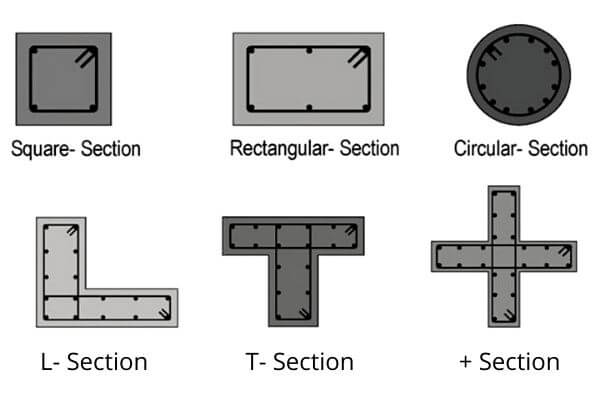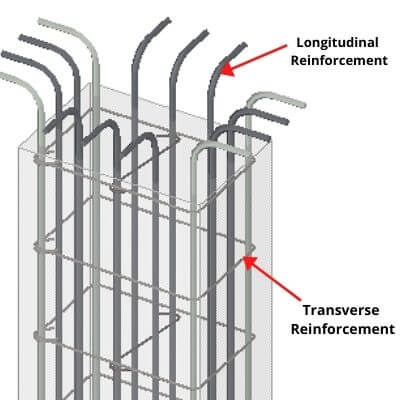Table of Contents
What is Column?
A column is an essential component of an RCC structure. A column may be described as a structural member carrying the direct axial load that induces compressive stresses of such magnitude that they considerably govern its design.
It is a compression member of a structure whose effective length is three times greater than its least lateral dimension. If a member is vertical and mainly carrying axial load refers to the column.
While when the structure is inclined or horizontal, it refers to strut. Based on structural and architectural needs, columns may be of different shapes such as rectangular, square, circular hexagonal, etc.
Types of Column
Based on different criteria columns may be classified are as follows:
- Cross-section Shape
- Square
- Rectangular
- Circular
- Pentagonal
- Hexagonal
- Octagonal
- T-shape
- L-shape
- Material Used For Construction
- Timber Columns
- Masonry Columns
- RCC Columns
- Steel Columns
- Composite Columns
- Loading Type
- Axially Loaded Column
- Eccentrically Loaded Column
- Slenderness Ratio
- Short Column
- Long Column
- Lateral Reinforcement
- A column with longitudinal steel and lateral ties
- A column with longitudinal steel and spiral ties

Also, Read – What is Concrete Cover? Clear Cover, Nominal Cover and Effective Cover.
Types of reinforcement in Column
Mainly two types of reinforcement are provided in an RCC column are as follows.
Longitudinal Reinforcement
The longitudinal reinforcement steel bar is made up of steel bars organized longitudinally in a column. Longitudinal reinforcement also refers to the main steel bars. The purposes of the main steel bars are as follows:
- It helps to deal with the compressive loads and concrete, consequently reducing the column’s overall size and giving more usable area.
- It helps to withstand tensile stresses developed due to accidental eccentricity or moment.
- Steel is a ductile material that gives ductility to the column.
- It also reduces shrinkage and creeping effect because of continuous, uninterrupted loading applied for an extended period.
- It avoids sudden brittle ductility of the column.

Transverse Reinforcement
The transverse reinforcements, also known as stirrups or rings, are arranged along the column’s lateral direction in ties or spirals surrounding the primary steel. The purposes of the transverse reinforcement are as follows:
- It holds the longitudinal bars in position during concreting.
- It prevents longitudinal bars from buckling.
- It resists diagonal tension caused by transverse shear due to transverse load or moment.
- It gives certain ductility to the column
- It helps to confine the column, thereby prevent the column’s longitudinal splitting or concrete bulge out.
How to Design Column
An RCC Column may be designed in the following step:
1. Based on the concrete grade to be used, determine the allowable stresses in the concrete, main bars, and ties.
2. Calculate the superimposed load the column is expected to carry. For this, add the column’s dead weight(assumed) to get the total load the column has to take at its base.
3. Consider some suitable value of reinforcement Asc says between 0.8 to 2% of gross area A of the column. Determine area A from the following expression.
P = σccAc + σscAsc
P = σcc( Ag – p.Ag) + σsc .pA
Ag = P/ σcc(1- p)+p.σsc
Where A = Column’s gross area
And p = ratio of steel to gross area = Asc /Ag.
4. After calculating the area Ag, now determine the column’s dimension. If it is square of side b, then b =√Ag. If a circular column of diameter D is to be used, D (=b) will be equal to√4Ag/π.
5. For the known end condition, calculate the column’s effective length lef and calculate the lef /b ratio to decide whether it is a short column or a long column.
6. If lef /b<12, then the column will be designed as a short column for which dimensions have been determined in steps 3 and 4. Calculate the steel area Asc and distribute the bar suitably around the column’s periphery, keeping suitable cover.
7. If lef /b > 12, then the column will be designed as a long column for which the reduction factor Cr is calculated from the expression,
Cr = 1.25 – lef /48b
For an equivalent short column, calculate the design load p’.
P’ = P/Cr
Using the received value of P’, re-calculate the area Ag and determine the column’s size. Also, determine the steel Area Asc = pAg.
8. Determine the diameter of bars used as ties and calculate its pitch as per known rules.
Example – Find the safe load that column can carry for the data given below.
Effective Length = 4 meter
Diameter = 400 mm
Main Bar = 8 nos of 20 mm diameter
Concrete Grade = M 20
Steel = Fe 415
Solution – First we will found out given column is a short or long column.
Effective length = 4 meter = 4000 mm
Hence lef/b = 4000/400 = 10<12
Hence the column is short.
The formula for load calculation is
P = P = σccAc + σscAsc
Area of steel (Asc) = 8π/4 (20)2
= 2513.3 mm2
Area of column Ag = π/4(400)2
= 125664 mm2
Area of Concrete Ac = Ag – Asc = 125664 – 2513.3 = 123151 mm2
For M 20 Concrete = 5 n/mm2
For Fe 415 steel = 190 n/mm2
P = (5 × 123151) + (190 × 2513.3) = 1093281 N or 1093.281KN
If the effective length is increased to 8 m then what will be the safe load that column can carry?
For effective length = 8 meter = 8000 mm and D = 400 mm
lef/b = 8000/400 = 20 >12
Thus the column is a long column for which we have to calculate the reduction factor.
Cr = 1.25 – lef /48b
= 1.25 – 8000/(48 × 400) = 0.8333
P = 0.8333 × 1093281 = 911067 = 911.067 KN
Also, Read
Types of Foundation and Footing and Their Uses
Difference Between Pre tensioning and Post Tensioning
What is Development Length? Complete Guide
What is Lap Length? How to Calculate it? Complete Guide